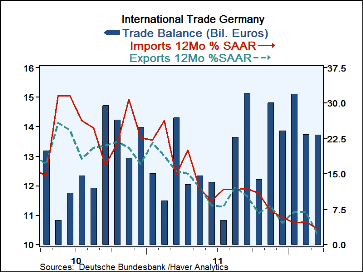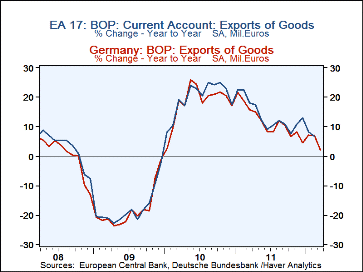 Global| May 09 2012
Global| May 09 2012German Trade Balance Steadies on Solid Exports
Summary
The German trade deficit is stabilizing in the 13bln to €14bln range. Nominal export and import growth rates are accelerating sharply; led by import growth. And real export orders are continuing to grow. However Yr/Yr trends on [...]
The German trade deficit is stabilizing in the €13bln to €14bln range. Nominal export and import growth rates are accelerating sharply; led by import growth. And real export orders are continuing to grow.
However Yr/Yr trends on nominal growth show a stayed decline in momentum for exports and for imports with exports actually weakening a bit faster recently. While the simple monthly members seem to be reassuring the 12-month trends are anything but reassuring.
But German data are on a bit of a roll right now with the last German industrial orders and industrial output reports being much stronger than had been expected.
In real terms German exports are in fact holding up slightly better. But global export growth has slowed. Japan has been taken out of the export picture with its export growth volumes falling from growth at over a 40% annual rate in 2012 to rates just under zero. There is continuing weakness in exports in the UK. Despite falling unit labor costs in Spain’s export volumes are still weakening. US export trends are just ahead of Germany’s trends. But in overall nominal terms Germany is not doing much differently than EMU as a whole (see chart above).
The export data paint a clear picture of global export growth being slow based on this small but solid set of countries. In Germany exports appear to be holding up, but in a broad context they are still part of a global slowdown. Still, the Zone is a growth-challenged place. Yet recent German activity reports have been upbeat. With the new problems for Greece on the board it is just about anything goes right now in Europe. Spain is trying to address its neglected banking sector problems. Greece is a wild card. And German data are hopping all over the place –possibly accelerating- making it difficult to figure out what is really going on there. Risk remains high. The danger of contagion hangs in the air.
Robert Brusca
AuthorMore in Author Profile »Robert A. Brusca is Chief Economist of Fact and Opinion Economics, a consulting firm he founded in Manhattan. He has been an economist on Wall Street for over 25 years. He has visited central banking and large institutional clients in over 30 countries in his career as an economist. Mr. Brusca was a Divisional Research Chief at the Federal Reserve Bank of NY (Chief of the International Financial markets Division), a Fed Watcher at Irving Trust and Chief Economist at Nikko Securities International. He is widely quoted and appears in various media. Mr. Brusca holds an MA and Ph.D. in economics from Michigan State University and a BA in Economics from the University of Michigan. His research pursues his strong interests in non aligned policy economics as well as international economics. FAO Economics’ research targets investors to assist them in making better investment decisions in stocks, bonds and in a variety of international assets. The company does not manage money and has no conflicts in giving economic advice.








